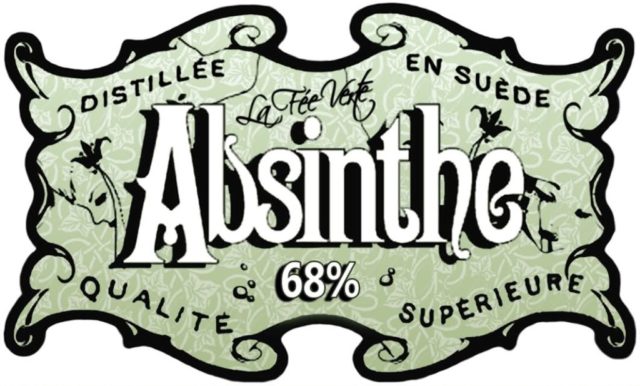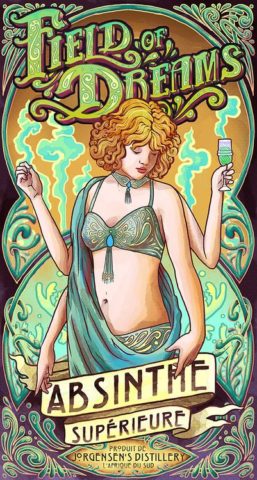 Let me re-tell the Tale of two Spirits. Of two generations of highly creative people in two different lands, united in their raw creativity and their “weaknesses” (I personally prefer the term “willingness” – to indulge, imbibe) for their preferred poison.
Let me re-tell the Tale of two Spirits. Of two generations of highly creative people in two different lands, united in their raw creativity and their “weaknesses” (I personally prefer the term “willingness” – to indulge, imbibe) for their preferred poison.
Ernest Hemingway, James Joyce, Charles Baudelaire, Paul Verlaine, Arthur Rimbaud, Henri de Toulouse-Lautrec, Amedeo Modigliani, Pablo Picasso, Vincent van Gogh, Oscar Wilde, Marcel Proust, Aleister Crowley, Erik Satie, Edgar Allan Poe, Lord Byron and Alfred Jarry were all … “artists” you said? You got it wrong, my friend. They were all known Absinthe drinkers.
Absinthe? Yes, Absinthe is historically described as a distilled, highly alcoholic beverage. It is an anise-flavoured spirit derived from botanicals, including the flowers and leaves of the grand wormwood, together with green anise, sweet fennel, and other medicinal and culinary herbs. Absinthe traditionally has a natural green colour but may also be colourless. It is commonly referred to in historical literature as the “green fairy”.
Shakti Chatterjee, Kamal Kumar Majumdar, Ritwik Ghatak, Sunil Gangopadhyay, Sarat Mukhopadhyay, like a host of others, the leading lights of a lost generation, were similarly known for their fondness for a firewater of another kind – “dushtu jol” (or naughty water, as they called it fondly). Locally brewed and distilled, this Bangla Mod (Country Liquor if you may, Indian Made Indian Liquor, IMIL, officially) was the fuel that quite literally had made art sprout, leading to an awakening of another kind.
Absinthe originated in the canton of Neuchâtel in Switzerland in the late 18th century. It rose to great popularity as an alcoholic drink in late 19th- and early 20th-century France, particularly among Parisian artists and writers. Owing in part to its association with bohemian culture, the consumption of absinthe was opposed by social conservatives and prohibitionists.
Bangla Mod’s origins are not that clear, dating as it does, back into the unknown mists of time, with some apologists tracing its history back to the Gods. However, that it was the chosen brew of the land since time immemorial is a fact that is universally acknowledged.
Absinthe has often been portrayed as a dangerously addictive psychoactive drug and hallucinogen. By 1915, absinthe had been banned in the United States and in much of Europe, including France and Switzerland. Although absinthe was vilified, it has not been demonstrated to be any more dangerous than ordinary spirits. Recent studies have shown that absinthe’s psychoactive properties (apart from that of the alcohol) have been exaggerated. A revival of absinthe began in the 1990s, following the adoption of modern European Union food and beverage laws that removed longstanding barriers to its production and sale. Currently, nearly 200 brands of absinthe are being produced in a dozen countries, most notably in France, Switzerland, Australia, Spain, and the Czech Republic.
 Bangla Mod too has been castigated by those who have been deprived of its heavenly influence. Some have screwed their elitist noses at the sheer brilliance of Ritwik, others have blamed it ruefully for the sad demise of the talent that was Shakti, while others have tended to look down upon the drink as the chosen one of the hungryalists, seeking to restrict it to the confines of its sanctum sanctorum – Khalashitola (literally the abode of the dockers, the porters).
Bangla Mod too has been castigated by those who have been deprived of its heavenly influence. Some have screwed their elitist noses at the sheer brilliance of Ritwik, others have blamed it ruefully for the sad demise of the talent that was Shakti, while others have tended to look down upon the drink as the chosen one of the hungryalists, seeking to restrict it to the confines of its sanctum sanctorum – Khalashitola (literally the abode of the dockers, the porters).
My contention is simple. If Absinthe can bask in the glory of the work of those who imbibed it, why can’t “Bangla” flaunt its extremely rich cultural heritage? Why will successive generations continue to look down upon it with mirth, scorn even? Why can’t the same Bhadroloks (Bengali gentlemen) who adorn their libraries with the works of Shakti and Sunil, reserve the pride of place for the bottle of Bangla in their Bars? Why is this duplicity, this Janus Face when we come to the real Spirit of Bengal (pun intended)? Honestly, can we brand the state, without branding the spirit that bears it name?
I have no answers to these questions. Not that I am terribly bothered about the answers either. For, I know what I am destined to do. And I have already embarked on my voyage. Yes, I will brand “Bangla” and ensure that it finds it rightfully place in the Bengali consciousness. I will brand Bangla and ensure that it reflects the romanticism that surrounds it. I will brand Bangla and see to it that it is held in the kind of reverence that it deserves.
Want to join me in this crusade of mine? Write in, at the least, you can be a part of the debate. For starters, how do you like the name – Banglar nobo-Jagoron er Suchona? (the beginning of Bengal’s revival)
(Monoranjan Roy is a youngest first generation entrepreneur, who, by dint of his sheer hard work, has built up the PSL Group, over which he presides as the Chairman & Managing Director. Pincon Spirit Limited has five distinct revenue streams – business verticals, if you may – Alcoholic Beverages, Edible oil, Lifestyle, Real Estate & Education; making it virtually unassailable and almost immune to commodity and market cycles. Within the alcoholic beverages segment, it has a near dominating presence in all the product categories and is the proud owner of some of the most valuable brands. He is widely acknowledged for his devoted contribution to the popularisation of the traditional country spirit and has some very exciting growth plans for PSL in the future.)

Very nice post here thanks for it I always like and search such topics and everything connected to them.Excellent and very cool idea and the subject at the top of magnificence and I am happy to comment on this topic through which we address the idea of positive re like this.
Gorbo korar Moto uddog. Joi HOK Monoronjon babu’r. Bangla fire Pak tar harano gourob.